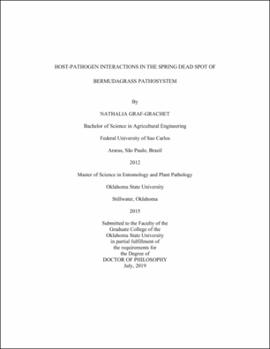| dc.contributor.advisor | Walker, Nathan R. | |
| dc.contributor.author | Graf-Grachet, Nathalia | |
| dc.date.accessioned | 2021-10-21T15:42:52Z | |
| dc.date.available | 2021-10-21T15:42:52Z | |
| dc.date.issued | 2019-07 | |
| dc.identifier.uri | https://hdl.handle.net/11244/331141 | |
| dc.description.abstract | Ophiosphaerella herpotricha, O. korrae and O. narmari are the causal agents of spring dead spot of bermudagrass (Cynodon spp.). These pathogens colonize roots of susceptible bermudagrass causing necrosis and death of plants. Bermudagrass mortality is likely due to weakening of rhizomes and stolons by means of nutrient depletion and reduced function of rotted roots that enhance cold temperature sensitivity. Limited information is available regarding host-pathogen interactions in this pathosystem. Although categorized as necrotrophs, the strategy of pathogenesis and genetic information of these pathogens has remained unknown. Additionally, the underlying genetics of root colonization by these pathogens has not been fully elucidated. Therefore, the goal of this research was to use a bioinformatic approach to elucidate the genes expressed by Ophiosphaerella spp. during colonization, and to identify gene(s) from bermudagrasses that determine host susceptibility and tolerance. This study produced the first report of draft genomes of eleven Ophiosphaerella isolates. Candidate necrotrophic effector genes were identified in their genomes, which were also found to be upregulated in planta. This might imply that Ophiosphaerella-induced necrosis is the result of pathogen-associated molecular pattern-triggered immunity (PTI). Expression profiling analysis of roots of susceptible bermudagrass cultivar 'Tifway' infected with O. herpotricha demonstrated activation of PTI mediated by jasmonic acid potentially resulting in necrosis. The tolerant 'U3' biotype showed activation of basal defense response mediated by salicylic acid. This salicylic acid-mediated signaling could be involved in enhanced resistance to nutrient starvation and cold tolerance that allows the host to withstand pathogen infection. Future experiments are required to functionally characterize the roles of these bermudagrass candidate genes in the host-pathogen interaction, which suggest a symbiotic relationship. The results presented will serve as valuable genomic resources for future studies in these plant-pathogen interactions and population genetics in the spring dead spot of bermudagrass pathosystem. Moreover, this will enhance traditional breeding efforts to incorporate better host plant tolerance to the SDS fungi in bermudagrass cultivars. | |
| dc.format | application/pdf | |
| dc.language | en_US | |
| dc.rights | Copyright is held by the author who has granted the Oklahoma State University Library the non-exclusive right to share this material in its institutional repository. Contact Digital Library Services at lib-dls@okstate.edu or 405-744-9161 for the permission policy on the use, reproduction or distribution of this material. | |
| dc.title | Host-pathogen interactions in the spring dead spot of bermudagrass pathosystem | |
| dc.contributor.committeeMember | Garzon, Carla D. | |
| dc.contributor.committeeMember | Young, Carolyn | |
| dc.contributor.committeeMember | Marek, Stephen | |
| dc.contributor.committeeMember | Fontanier, Charles | |
| osu.filename | GrafGrachet_okstate_0664D_16378.pdf | |
| osu.accesstype | Open Access | |
| dc.type.genre | Dissertation | |
| dc.type.material | Text | |
| thesis.degree.discipline | Plant Pathology | |
| thesis.degree.grantor | Oklahoma State University | |
